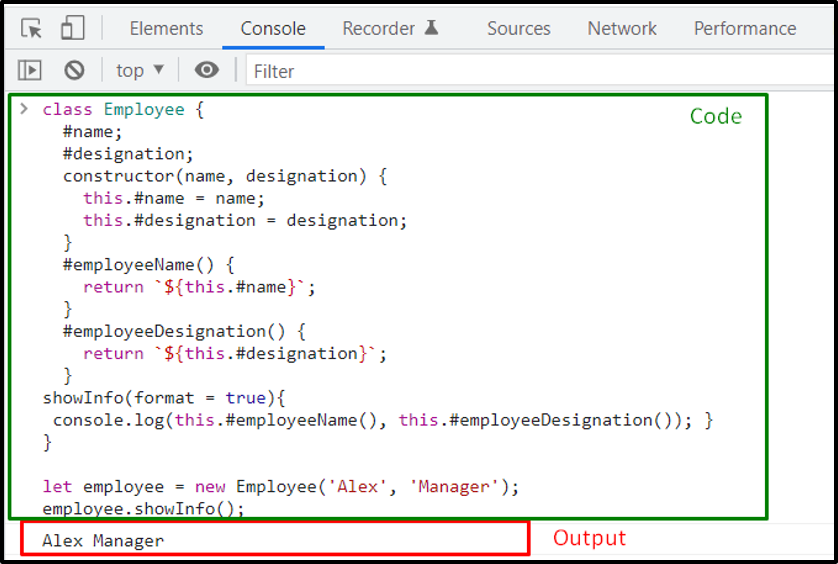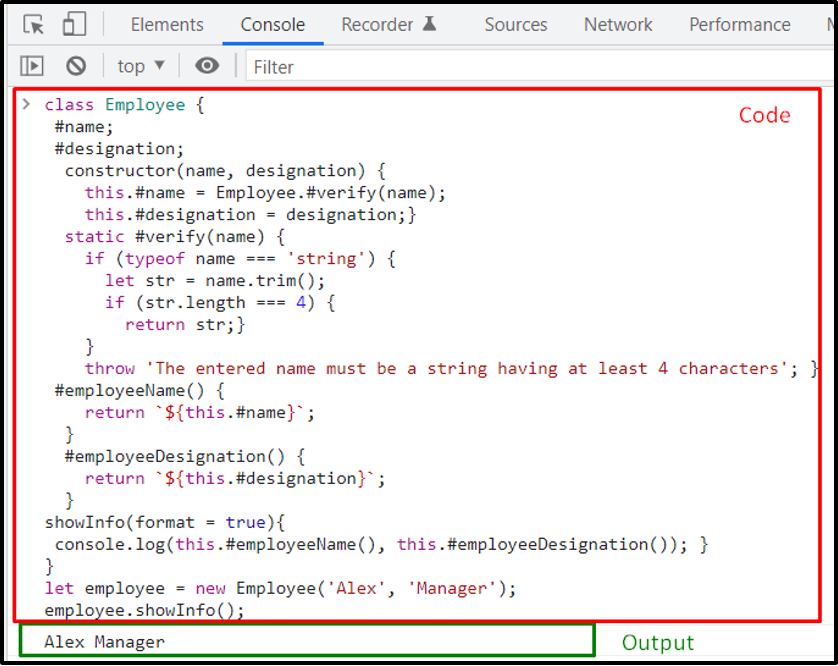This write-up will explain the procedure to define Private Methods in JavaScript. So, let’s start!
Private methods in JavaScript
The type of methods that cannot be accessed outside of the class where it is defined or by the base class is known are Private methods. These methods are utilized to secure the sensitive information stored in class fields such as personal information or passwords.
In a JavaScript class, to declare something as “private,” which can be a method, property, or getter and setter, you have to prefix its name with the hash character “#”.
Syntax of Private instance method
#privateMethod() {
// body of privateMethod
}
}
In the above-given syntax, the private instance method is “#privateMethod”, which can be only invoked within “NewClass” and you cannot access it in the subclass of “NewClass” or from outside.
“this” keyword is used for calling the “#privateMethod()” inside of the created “NewClass”:
Private Static Methods in JavaScript
Private static methods are loaded in the memory before you create an instance of that specific class and they are independent of class instantiation.
Syntax for defining a private static method
In a JavaScript program, to define a private static method, you have to use the keyword “static” before adding the method name with the “#” character:
static #privateStaticMethod() {
// body of the privateStaticMethod
}
}
Now, to invoke the created static private method, we will specify the class name “NewClass” instead of using “this” keyword:
Private Getters and Setters in JavaScript
In JavaScript, private getters and setters are used for retrieving and setting the private fields of a class.
Syntax for defining private getters and setters
In JavaScript, “get” and “set” keywords are utilized for creating getters and setters for the private fields:
#firstField;
get #field() {
return #firstField;
}
set #field(value){
#firstField = value;
}
}
How to define Private Methods in JavaScript
The private methods in JavaScript can keep your data private. It is preferred to define all class methods as “private” by default. After that, if an object needs to interact with other class objects, you can turn it to a “public” method.
Example: How to define Private Methods in JavaScript
First of all, we will create an “Employee” class having two private fields: “#name” and “#designation”. After doing so, we will add a constructor:
#name;
#designation;
constructor(name, designation) {
this.#name = name;
this.#designation = designation;
}
Next, we will define the private methods “#employeeName()” and “ #employeeDesignation()” for getting the values of the added private fields:
return `${this.#name}`;
}
#employeeDesignation() {
return `${this.#designation}`;
}
A “showInfo()” public function is also added in our Employee class which will invoke the following private methods:
console.log(this.#employeeName(), this.#employeeDesignation()); }
}
After setting up the Employee class, we will create an “employee” object while passing “Alex” and “Manager” as the values of the “name” and “designation” fields:
Lastly, we will invoke the “showInfo()” method by utilizing the employee object:
Execution of the above-given program will display the private field values of “employee” object in the console:
Example: How to define Private Static Methods in JavaScript
We will add a “#verify()” private static method in the Employee with “name” parameter. The “#verify()” method will check if the length of “name” is greater than or equal to “4“; otherwise, it will throw an exception stating that “The entered name must be a string having at least 4 characters”.
The mentioned static private method will be added in the Employee Class constructor so that it can validate the “name” argument before assigning it to the corresponding attribute:
#name;
#designation;
constructor(name, designation) {
this.#name = Employee.#verify(name);
this.#designation = designation;}
static #verify(name) {
if (typeof name === 'string') {
let str = name.trim();
if (str.length === 4) {
return str;
}
}
throw 'The entered name must be a string having at least 4 characters';
}
#employeeName() {
return `${this.#name}`;
}
#employeeDesignation() {
return `${this.#designation}`;
}
showInfo(format = true){
console.log(this.#employeeName(), this.#employeeDesignation()); }
}
In the first case, we will create an “employee” object and pass a name which will meet the added condition in the #verify() static private method:
employee.showInfo();
After validating the #name field, it can be easily fetched by the showInfo() method:
For the second time, we will specify a name which comprises three characters:
employee.showInfo();
You can see from the below-given output that the added static private method has thrown an exception for the employee name:
The name “Sia” which we have passed in the Employee Constructor is not according to the “if” statement specified in the static #verify() method. That’s why the “employee” instance is not created.
Why you should use Private Methods in JavaScript
Here is a list of some of the advantages of using private methods in JavaScript:
- Encapsulation is one of the key advantages of using private methods as it permits interfaces to hide the implementation details from other classes.
- It also improves the readability of the code.
- Defining private methods also ensures code re-usability and avoids code duplication.
- If you declare all of your methods as “public”, you have to keep a check on who is going to read and make changes to the class properties.
Conclusion
Private methods are defined in JavaScript to hide crucial class methods or keep sensitive information private. In a class, to define a private method instance, private static method, or a private getter and setter, you have to prefix its name with the hash character #. This write-up explained the procedure to define the private methods in JavaScript with the help of suitable examples.



